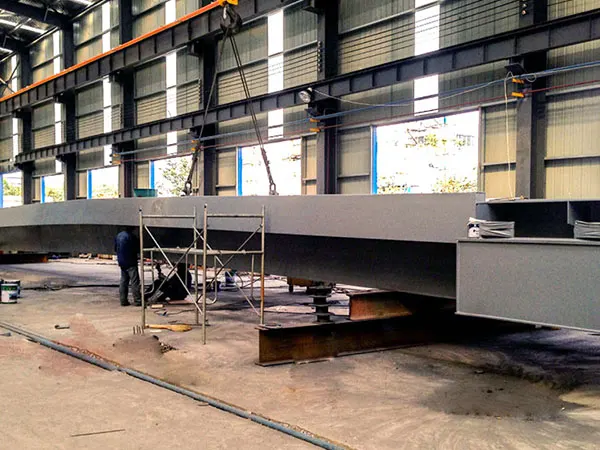Box-type steel structural components, also known as hollow structural sections (HSS), are a type of structural member with a hollow, box-like cross-section, most commonly square or rectangular. They are used in construction because they have a high strength-to-weight ratio and excellent resistance to torsional (twisting) forces.

Box-type steel structural components, also known as hollow structural sections (HSS), are a versatile and popular choice in construction and engineering. They are distinguished by their hollow, box-like cross-section, which can be square, rectangular, or circular. This design provides several advantages over other steel profiles, such as I-beams or channels.
Cross-Section Height (H): 200 mm to 3,000 mm or larger
Cross-Section Width (B): 200 mm to 2,000 mm
Sheet Thickness (t): 6 mm to 80 mm (depending on load requirements)
Cross-Section Shape: Rectangular, square, trapezoidal, ribbed box-type, double-chamber box-type, etc.
Component Length: ≤ 15m (single section), can be field-assembled for longer lengths
Steel Material: Q235B, Q355B, Q355D, Q460, etc. high-strength steel
Connection Method: Welding as the main method, with some sections assembled using high-strength bolts
1. High load-bearing capacity: The closed box-shaped cross-section structure offers excellent bending, torsional, and compressive strength, making it suitable for large-span, high-load engineering structures.
2. Excellent structural stability: The closed cross-section reduces the likelihood of local buckling, provides high overall stiffness, and offers strong resistance to lateral displacement.
3. Sleek appearance and easy maintenance: The structure has a neat appearance with a smooth surface, facilitating corrosion protection, painting, and maintenance.
4. Excellent corrosion resistance: The closed structure minimizes the ingress of rainwater and dust into the interior, enhancing durability, particularly suitable for outdoor or humid environments.
5. Diverse connection methods: Welding, bolted connections, and other methods can be used, facilitating integration with other components.
6. Relatively high manufacturing complexity: Due to the closed structure, the manufacturing process involves extensive welding and internal cavity corrosion protection treatment, requiring high manufacturing precision.
1. Bridge structures: Box girders are widely used in highway bridges, urban interchange bridges, railway bridges, and other applications requiring high structural stability and load-bearing capacity.
2. High-rise building columns/support systems: Used as core columns or external frame columns to enhance seismic and wind resistance.
3. Large industrial plant steel columns and trusses: Especially suitable for heavy-load areas such as crane beams and overhead crane track beams.
4. Tall structures, chimneys, communication towers, etc.: Box-type components have high rigidity and wind resistance, making them suitable for tall structures.
5. Public building structures such as subway stations and airport terminals: Box-type beams or columns are commonly used in spatial structures requiring large open spaces with minimal or no columns.
6. Port machinery structures: Such as crane main beams and gantry structures, which are heavy-duty mechanical support components.
|
Key Requirements |
Material |
Cross-Section Type Plate Thickness (mm) |
Surface Treatment Methods |
|
High Load-Bearing Column |
Q355D/Q460 |
Square/rectangular box columns 20~50 |
Three-coat system + fireproof coating |
|
Large Span Beam |
Q355B |
Rectangular box girder 10~25 |
Epoxy primer + polyurethane topcoat |
|
Use in Humid/Coastal Areas |
Q355D |
Fully welded enclosure box type ≥12 |
Hot-dip galvanizing or metal spraying |
|
Quick Assembly/On-site Welding |
Q235B/Q355B |
Prefabricated box type 6~20 |
Simple coating or workshop primer coating |
Box-type steel components are typically manufactured using one of two methods:
Hot-Forming: Steel is heated to a high temperature, then rolled into the desired shape. This method creates a seamless, uniform section.
Cold-Forming: Steel plates are bent into shape at room temperature and then welded together along the edges to form the hollow section. This is a common method for creating larger, custom-sized components.

Create the greatest value for customers
Provide the best quality products and services
+8618800767079
info@hcggsteel.com
No.1 Shuangxiang Road, Luoxin Industrial Park, Luoyang City